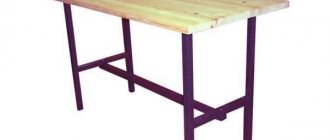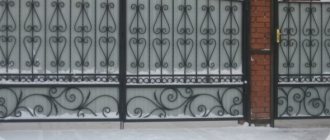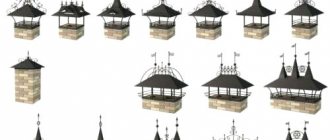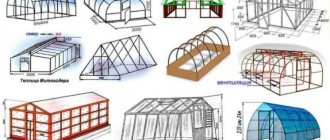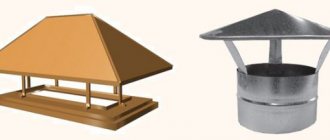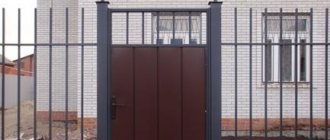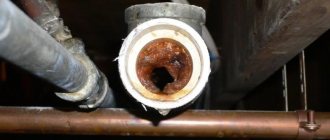Hello readers!
Today I want to talk about asbestos-cement pipes. Asbestos cement pipes have been actively used for several decades in various fields of construction, for household needs and in everyday life. Sometimes analogues to this material simply do not exist.
What, for example, is the best material to use to build an exhaust pipe in the basement or to lay ventilation in the ground layer?
The excellent properties of thick-walled asbestos-cement pipes are well known. They are resistant to dampness, rotting, decomposition, and high mechanical loads.
In the process of performing many types of work, there is often a need to cut off a piece of pipe or shorten an existing piece.
You can't do it just like that, very quickly. If you apply significant force to some part of the pipe, the pipe will simply burst. But we want to get even cuts.
Therefore, the cutting process should be approached thoroughly and knowledgeably. For example, you will not be able to perform such an operation in the same way as you can do with asbestos-cement slate.
As you know, slate can be pierced with a nail in several places and then broken along the made line. It is impossible to pierce the pipe like this due to its thick walls.
How to cut an asbestos cement pipe
There are several ways to cut asbestos-cement pipes, which will be presented below:
1. Cutting with a regular hacksaw for metal. The complexity of this method lies in the fact that dry material is cut very poorly, and the blade quickly becomes dull. Often, to cut a pipe with a diameter of 10 cm, you may need a dozen hacksaw blades.
The solution is to cut the wet material. However, simply moistening the cut area with water will not be enough. Asbestos absorbs moisture very slowly. The pipe must be wrapped in cloth or thick cardboard, and then the surface must be moistened. Keep the pipe in this condition for a couple of hours, periodically wetting the cloth or cardboard.
A cutting line should be drawn on the wet surface of the pipe, after which you can begin cutting. A pipe saturated with moisture will be cut very easily, and the number of dull blades will be reduced.
2. Using a grinder. Using this tool, a pipe of any diameter can be cut in a couple of minutes. However, do not use cutting wheels for this, as they wear out due to friction against the pipe at great speed. Place a diamond wheel of the appropriate diameter on the grinder and get to work.
When a high-speed tool impacts the pipe surface, a large amount of asbestos dust is released, which has a detrimental effect on the respiratory tract. To prevent this, periodically moisten the cut area with water. It will be even better if the master is directly involved in cutting the pipe, and his assistant is to moisten the cut area with water.
3. Use of a special cutter. Since such tools are used relatively rarely and are quite expensive, this cutting method has not gained much popularity. However, when there is a massive cutting of asbestos-cement pipes, the cutter is able to put the cutting process on stream.
The work is performed in the following order. A line for the future cut is drawn along the circumference of the pipe. Then a recess of a couple of millimeters is cut with a cutter. After this, the pipe can be easily broken by placing a hard roller under one of its sides.
Using one of these methods, you will be able to cut an asbestos-cement pipe of any diameter smoothly and correctly in a short time.
Source:xn—-7sbacnvl3bgmicni.xn--p1ai
A circular saw
A hand-held circular saw has an impressive list of advantages. Among them:
- ability to adjust cutting depth;
- high purity of processing;
- acceptable noise level;
- relatively low hazard indicator, controllability;
- no smoke or dirt is produced - only small sawdust.
To operate a manual-grade circular saw, you don’t need much skill. The recommended course of action for beginners involves installing a reliable support for the movement of the sole of the tool and working on a table.
By adjusting the plunge of the saw blade, you can cut laminate without damaging the surface of the workbench or other support. The main disadvantage of a circular saw is that not everyone has such a tool; it is irrational to buy it specifically for laying laminate floors.
Cutting asbestos-cement pipes with an angle grinder
The most common method is cutting asbestos-cement pipes with an angle grinder (also known as angle grinder, grinder; something like BOSCH GWS 850 CE Professional or MAKITA GA5030K).
In this case, there are 2 types of work, depending on the equipment used:
- Grinder with a disc for stone . Cutting using this method requires the effort of two people. One of them should cut the pipe with a grinder, and the second should spray a very thin stream of water onto the cutting site. In this case, the dust from cutting will not scatter throughout the room, but will flow down in the form of dirt.
- Grinder with a diamond blade . Here you will need a respirator, construction glasses and other protective equipment. To reduce the amount of dust that gets on a person when cutting, you need to carry out this process in an open space on the leeward side so that all the dust flies to the side. If you cut a pipe in winter, you can lay it directly on the snow so that the particles of material remain below.
Physical properties of the material
To make slate, manufacturers mix asbestos with cement and water, pour it into molds and leave it to dry. To prevent dusting, both sides and cuts are coated with a special paint, which gives the desired shade to the material and makes it smoother . Slate has the following physical characteristics:
- Heavy weight. The weight of one standard size sheet exceeds 30 kg. Among roofing materials, it has a large weight, which is exceeded only by ceramic tiles.
- Fragility. It is quite easy to damage the integrity of a slate sheet. On the one hand, this is bad, since you need to be more careful about transportation and storage. On the other hand, this is a definite advantage, since cutting the sheet is not particularly difficult.
- Color. Unpainted slate is easily recognized by its light gray tint, which cannot be confused with anything else. If it seems unsightly or does not harmonize with the decoration of the house, simply buy paint and apply it to the surface of the roof.
- Variety of textures. Manufacturers of building materials produce wave and flat slate. Without differing in composition, they have different surfaces and different areas of application. The wave type is often used to cover roofs, and the flat type is used to protect walls.
Dimensions and weights of different types of slate sheets
Note! Slate is made using asbestos. This insidious mineral of the silicate class penetrates with dust into the lungs, irritating and causing microtrauma. Therefore, to cut a sheet of slate, you need to use personal protective equipment that protects the respiratory tract and eyes. It is best to cut not indoors, but outdoors.
And if not, alternative technologies
If you don't have an angle grinder, you can use a cutter or hacksaw. Let's consider these technologies for cutting asbestos-cement pipes.
- Hacksaw. It is quite possible to cut a pipe with a regular hacksaw, but it will take quite a lot of effort and time. Initially, the pipe should be wetted, since asbestos cement is cut much easier in its wet state, and if you cut the pipe dry, the process will become extremely tedious and ineffective. Then you should mark the cut line, moisten rags in water and lay them for several hours along the intended cut site. Wet asbestos cement will be much more elastic and will cut easily. Do not press too hard on the pipe when cutting to prevent it from splitting.
- Cutter. To do this, you will need a cutter similar to a plastic cutter, but larger in size and made of high-quality metal. The pipe should be placed on a flat surface and, using a ruler, make a scratch on the cutter in the form of a straight section. Then deepen it a millimeter and further. You can place a small strip inside the pipe under the scratch and break it along the cut line. This process does not generate much dust.
The above methods for cutting asbestos cement are the most popular, but if they do not suit you, you can use alternative technologies:
Classic axe. You need to take an ordinary ax and cut the pipe along the marked lines.
It is worth understanding that many blows must be applied to the same place in order to initially break the pipes, and then the process will go much faster. Of course, you won’t be able to cut the pipe evenly, but it will be effective and quick. Circular .
You can cut an asbestos cement pipe using a circular saw. Instead of the usual disk, you need to install a disk with carbide teeth on it. Slate nail. If you do not have all the listed tools at hand, you can use the most primitive method. First, a cut line is marked on the pipe, then a slate nail is taken and a line is punched along the entire circumference.
The more frequently the holes are located, the better. It is best to place a thin oblong object, such as a block of wood, under the pipe. At the end, you need to carefully break the pipe along the line with the holes. The cut line will not be perfectly straight, in any case, it all depends on the number of holes made and the accuracy of the break.
Asbestos cement pipes have been actively used for several decades in various fields of construction, for household needs and in everyday life. Sometimes analogues to this material simply do not exist.
What, for example, is the best material to use to build an exhaust pipe in the basement or to lay ventilation in the ground layer? The excellent properties of thick-walled asbestos-cement pipes are well known. They are resistant to dampness, rotting, decomposition, and high mechanical loads.
In the process of performing many types of work, there is often a need to cut off a piece of pipe or shorten an existing piece. You can't do it just like that, very quickly. If you apply significant force to some part of the pipe, the pipe will simply burst.
But we want to get even cuts. Therefore, the cutting process should be approached thoroughly and knowledgeably. For example, you will not be able to perform such an operation in the same way as you can do with asbestos-cement slate.
As you know, slate can be pierced with a nail in several places and then broken along the made line. It is impossible to pierce the pipe like this due to its thick walls.
There are several ways to cut asbestos-cement pipes, which will be presented below:
1. Cutting with a regular hacksaw for metal. The complexity of this method lies in the fact that dry material is cut very poorly, and the blade quickly becomes dull. Often, to cut a pipe with a diameter of 10 cm, you may need a dozen hacksaw blades.
The solution is to cut the wet material. However, simply moistening the cut area with water will not be enough. Asbestos absorbs moisture very slowly. The pipe must be wrapped in cloth or thick cardboard, and then the surface must be moistened. Keep the pipe in this condition for a couple of hours, periodically wetting the cloth or cardboard.
A cutting line should be drawn on the wet surface of the pipe, after which you can begin cutting. A pipe saturated with moisture will be cut very easily, and the number of dull blades will be reduced.
2. Using a grinder. Using this tool, a pipe of any diameter can be cut in a couple of minutes. However, do not use cutting wheels for this, as they wear out due to friction against the pipe at great speed. Place a diamond wheel of the appropriate diameter on the grinder and get to work.
When a high-speed tool impacts the pipe surface, a large amount of asbestos dust is released, which has a detrimental effect on the respiratory tract. To prevent this, periodically moisten the cut area with water. It will be even better if the master is directly involved in cutting the pipe, and his assistant is to moisten the cut area with water.
3. Use of a special cutter. Since such tools are used relatively rarely and are quite expensive, this cutting method has not gained much popularity. However, when there is a massive cutting of asbestos-cement pipes, the cutter is able to put the cutting process on stream.
The work is performed in the following order. A line for the future cut is drawn along the circumference of the pipe. Then a recess of a couple of millimeters is cut with a cutter. After this, the pipe can be easily broken by placing a hard roller under one of its sides.
Using one of these methods, you will be able to cut an asbestos-cement pipe of any diameter smoothly and correctly in a short time.
Asbestos-cement pipes are very popular in construction. It cannot be otherwise, because such pipes are easy to install, resistant to aggressive environments and have a service life longer than their metal counterparts.
But very often during work it is necessary to cut these products, so many people are concerned with the question: how to cut asbestos-cement pipes?
Work safety precautions and important recommendations ↑
How to cut slate is not as important as observing safety rules at work. The protection of the worker was discussed above. Particular care must be taken when working with high-speed power tools.
This primarily applies to grinders and hand-held circular saws. You should be equally careful when working with a jigsaw. All of these tools are very powerful and in the wrong hands can become a source of danger both for the worker and for others.
If cutting is happening for the first time or the worker has little experience, then it is better to make a reserve of about 10% per sheet. Such a reserve will allow us to cover losses due to chips and rejected material. Sawing asbestos-cement slate sheets is not as difficult as it might seem at first. However, to improve quality, it is better to practice on small fragments. This will allow you not only to get better at it, but also to practice a certain technique.
Cutting pipes with a grinder
- Grinder with a disc for stone. This type of cutting requires two people. One will cut the pipe with a grinder, and the second should pour a small and thin stream of water from a plastic bottle onto the cutting area. In this case, all the dust will not fly in the air, but will flow down in the form of dirt onto the ground.
With this cutting method, you need to immediately remove the remaining asbestos dust from the angle grinder and other objects, otherwise it will harden and it will be quite difficult to remove it later.
Types of slate
Among roofers, slate is the name given to several types of materials; their individual technical parameters have a direct impact on the choice of cutting method and tool.
Table. Types of slate
| Type of slate | Physical and operational characteristics |
| Wave asbestos-cement | Traditional roofing material was previously the most common. Made from cement and asbestos, it is prohibited for use in developed countries. The reason is that asbestos, when it enters the human body, provokes the development of malignant neoplasms. Wave slate is a fragile material; extreme caution should be used when cutting. |
| Flat asbestos cement | Flat slate is used to create temporary fencing for construction sites and summer cottages. Thickness up to 1 cm; during cutting, a large amount of dust harmful to health is generated. Flat slate has recently been used extremely rarely. |
Euroslate | The name is purely commercial; this material is not used in Europe to cover residential buildings and other prestigious buildings. It is made from pulp production waste and has very low physical strength. Cutting Euro slate is very simple. |
We will look at existing technologies for cutting all types of slate. This will take into account the practical experience of professional roofers, new tools and technological capabilities.
Prices for different types of slate
Slate
Calculator for calculating the amount of slate for a roof
Go to calculations
We cut pipes with a hacksaw and cutter
- Hacksaw. You can try cutting an asbestos-cement pipe with a hacksaw. But to do this, you need to wet the pipe, since it is much easier to cut asbestos cement in its raw form, and if you just cut the pipe, the process will be long and tedious. First, mark the cut line, then soak rags in water and lay them lengthwise at the cut site for two hours. Wet asbestos cement will become more elastic and cut much easier. Do not press too hard on the pipe, otherwise it may split.
- Cutter. You will need a cutter like for plastic, only larger and made of better steel. Place the pipe on a flat place and, under the ruler, make a scratch on the pipe with a cutter in the form of a straight line. Then deepen it to a millimeter and deeper. Place a thin strip inside the pipe under the scratch and break it along the cut line. There won't be a lot of dust.
Method 9. We cut metal with a multifunctional power tool (Renovator multitool, multicutter).
A new, widely advertised tool that comes with different attachments, including those used for cutting metal.
One of the promoted tool names is the Renovator multitool. True, other manufacturers (including Bosch, Dewalt, Makita, etc.) do not use this name. Due to its versatility, you should not expect serious capabilities for cutting large-sized metals from a renovator. Best used for trimming protruding nails, screws and other small metal cutting, especially in hard-to-reach places.
Other methods
- An ordinary axe. Take an ordinary ax and use it to chop the pipe along the marked lines. You will have to strike more than once at the same place to break the pipe initially, then the work will become easier. Of course, it won’t come out very smoothly, but it will be quick and effective.
- Circular. You can cut an asbestos-cement pipe using a circular saw. Instead of the usual disk, you need to put a disk with carbide teeth on it.
- Slate nail. If you don't have any tools, try this simple method. Mark a cutting line on the pipe, then take a slate nail and punch holes along the entire line. The more often the holes are located, the better. Place a thin, long object, such as a block of wood, under the pipe. Then carefully break the pipe along the line with the holes.
Of course, the cut line may turn out uneven, it all depends on the accuracy of breaking and the number of holes.
Source: pechi-sibiri.ru
Features of the production of asbestos-cement pipes
In the production of asbestos-cement pipes, the main components are:
Diameters of asbestos-cement pipes.
If everything is more or less clear with cement (as a rule, Portland cement of grade 500 and higher is used), then asbestos is used a fine-fiber mineral, which belongs to the class of silicates and has the ability to split into very flexible and thin fibers.
The main advantages of asbestos are its high tensile strength, elasticity, spinnability, resistance to aggressive environments (alkali and acid), fire resistance, and frost resistance.
Today, there are dozens of large asbestos deposits in the world, where it is mined industrially. The most famous deposit in our country is located in the city of the same name Asbest, in the Urals.
Asbestos-cement pipes are produced at asbestos-cement plants, where special equipment also produces asbestos-cement couplings - shells that connect asbestos-cement pipes. The diameter of the produced asbestos-cement pipes varies from 100 mm to 1 m.
In addition to the properties and advantages that asbestos gives them, these pipes are moisture and frost resistant. But there is a limit to everything. Sometimes you have seen asbestos-cement pipes that had lain on the surface of the earth for thirty to forty years, exposed to precipitation. Such pipes begin to collapse and delaminate.
Related Posts:
- How to cut plastic pipes
- How to bend a steel pipe
- How to connect asbestos-cement pipes. Connecting couplings.
- Steel Pipe Cutting Pipe Cutter for Steel Pipe
- How to connect copper pipes
- Copper pipes for air conditioners
Oh nail. Can I try drilling? If yes, then with what exercise.
Volpert-Grigorovich home deflector. How to make a deflector yourself and improve draft in a chimney firebox.
Source
Over the past 50 years, asbestos cement pipes have been very popular in a variety of applications. This is due to the fact that such products are quite easy to install, they are resistant to aggressive environments and last longer than their metal counterparts. However, there is often a problem with cutting asbestos cement pipes. How to do it right?
How to choose the right asbestos cement pipe?
In the building materials market, asbestos-cement pipes with an outer diameter of 100 or 150 millimeters are most popular among buyers. Their length is stated as 4 meters, but in reality it is 2-4 cm less.
But recently, most building materials are declared not according to GOST, but according to technical specifications (TU), which prescribe a significant spread of characteristics in one direction or another.
For example, according to the technical specifications, the size of the product (in our case, an asbestos-cement pipe) is stated to be 4 m with a possible maximum deviation upward or downward of 4 centimeters.
In order for an asbestos-cement pipe to last a long time, pay attention to its appearance. She should not have visible external deformations.
When choosing an asbestos-cement pipe, pay attention to its appearance. It should not have visible external deformations, chips, cracks, or peeling. Don’t be shy (or don’t be lazy) to take measurements of its main parameters yourself if these values can somehow affect the accuracy when installing pipes or during their direct operation.
Such defects occur, although not often, when when looking at an asbestos-cement pipe from the end it is noticeable that its hole is not round, but elliptical. It happens that the pipe has a bend along its entire length.
These are all defects that arose during factory production; they have virtually no effect on the strength of the product, and, at your discretion, you can put up with them. For example, you are planning to lay a telephone or electric cable along your cottage (dacha, etc.) area.
So what if the pipe is not completely round or has a slight bend along its length? It's not that important. But if you use an asbestos-cement pipe as a fence post, then visually it should be smooth.
It is very rare, but you can find painted asbestos-cement pipes on sale. It is good if the painting is done at the factory so that the pigment penetrates to a certain depth.
If you decide to paint a pipe yourself, be prepared for the fact that after a couple of years your paint will peel off in places, especially if your pipe is in direct contact with precipitation.
Cut plywood with your own hands
Sawing technology:
- All procedures are carried out according to drawings that are drawn up in advance. This will avoid mistakes.
- The marked slab is laid in the prepared place. It is important to ensure free passage of the disk or saw and rigid, stable placement of the resulting fragments.
- The exposed stop is fixed with clamps.
- Based on the most comfortable position, the largest possible cut is made. It is important to ensure that the parts - especially the part being processed - do not sag or jam the tool. Whenever possible, cutting is carried out without stopping.
- Figure cutting is performed in a single section or fragments, the excess is removed gradually.
The use of asbestos-cement pipes in construction
Arrangement of room ventilation
To install ventilation using asbestos-cement pipes, it should be noted that you need to start from the very bottom of the room (basement).
In practice, asbestos-cement pipes are used for the following purposes. With their help, ventilation of the room is arranged. They start from the very bottom of the room (basement), where it is necessary to install at least a couple of asbestos-cement pipes for air circulation.
The pipes must be placed diagonally; it turns out that in a quadrangular basement they will be placed in opposite corners. Due to this arrangement, the circulation will be more intense. It must be remembered that one pipe should be in close proximity to the basement floor, not reaching it by 15-20 centimeters.
The second pipe should be placed almost at the level of the basement ceiling, and if it protrudes, then only 5-7 cm above it. To avoid obstructing the air flow, there should be no objects near the pipes.
The opposite ends of the pipes should extend as high as possible, preferably above the roof of the building. Then there will be sufficient air draft to extract moist air from the basement.
Please note that in order to avoid moisture accumulation on the floor, it does not need to be cemented. Since water enters the basement through the soil, it must also exit through it. Otherwise, you will need to install a water pump to pump out moisture in the basement.
And if your basement is located below the groundwater level, then no asbestos cement will help. Then it is necessary to equip the so-called caisson - a closed volume, completely isolated from the ground, which does not allow the penetration of water.
An example of arranging room ventilation.
From time to time, injection (exhaust) air fans are installed in asbestos cement to enhance the ventilation of air flows. Moreover, it is not necessary to use powerful electric fans; sometimes self-cooling options with a power of no more than a few tens of watts are sufficient.
Often, asbestos-cement pipes are used to install ventilation holes in foundation plinths. If you have already prepared the formwork for pouring, for example, a strip foundation, then secure a pipe with a length equal to the width of the foundation to the formwork. This way you will get perfectly straight holes.
At the same time, remember that asbestos-cement pipes must be at a sufficient height from the surface of the earth so that moisture does not get into them, in particular from melted snow.
Regardless of the height of the pipeline, small rodents can use it to penetrate under the floor of the room, so use mesh or ventilation grilles.
It would be useful to remind you that with the onset of late autumn and until spring, in order to avoid cold air entering the premises, the pipe openings must be covered with insulation. Just remember to open these holes in the summer, as otherwise condensation will begin to accumulate under the floor, which can lead to the formation of mold and fungi.
Basic Rules
Despite the emergence of new materials for creating roofs, slate continues to be actively used in construction. When installing it, it becomes necessary to trim individual elements. This operation is specific: the gray roofing material contains asbestos fibers. They are carcinogenic. Inhaling asbestos dust can cause lung cancer. Therefore, you need to cut sheets very carefully, observing safety rules. They are extremely simple:
- Before work, you need to put on thick clothing that completely covers the body, gloves, safety glasses and a respirator. Cutting is always accompanied by a lot of noise; if you refuse to use earphones, you can become deaf for some time.
- It is important to thoroughly wet the surface of the roofing material before starting, then less dust will form. Experienced roofers, when talking about how to cut slate, advise watering it right while cutting. This is the most effective way to protect yourself as much as possible from inhaling the strongest carcinogen.
Slate must be moistened with water when cutting.
- The operation must be performed outdoors, preferably in a well-ventilated place. If you position yourself on it so that the wind immediately blows away the dust, which contains asbestos particles, you will be able to protect not only yourself, but also passers-by.
Sometimes it becomes necessary to cut slate indoors. In this case, you must first remove all workers from the room and leave only the operator in overalls. Before cutting, he must tightly close the windows and doors, cover them with old rags, and after cutting, collect the resulting dust with an industrial vacuum cleaner. The same technologies are used for cutting flat and wavy slate. But there are some nuances in the process of its implementation.
Cutting flat slate
On our website you can get acquainted with the most popular projects of houses with a hip roof - from construction companies presented at the exhibition of houses "Low-Rise Country".
Chimney made of asbestos cement
It must be remembered that asbestos-cement pipes should not heat up excessively and be in direct contact with a burning flame.
Often, asbestos-cement pipes are used as pipelines or draft channels in stove heating. It is clear that bricks are much better suited for this (excluding silicate bricks). You just need to remember that in this case, asbestos-cement pipes should not heat up excessively and be in direct contact with the burning flame.
If a pipe is installed as a chimney, for example, on the second floor, then the stove, which is located on the first floor, will heat up and then release its heat to heat the air around it.
Ideally, cover such a chimney with a pipe from the outside made, for example, of galvanized steel, and attach an umbrella (cap) on top, which is needed to solve two problems: protecting the chimney from moisture getting into it; thanks to a certain angle of the hood, a change in the flow of air moving under the influence of the wind, which creates additional draft for the escaping smoke.
Asbestos-cement pipes are also used to drain rainwater from sidewalks and paths near the house.
Conclusion
Cutting asbestos-cement slate with your own hands is quite possible. I can assure you that the methods presented above work, the only difference is the quality of the cut edge. If you have any questions, write in the comments, I will try to help.
Slate is still considered the most popular roofing material.
December 9, 2021
Tools and materials, Roofing
If you want to express gratitude, add a clarification or objection, or ask the author something, add a comment or say thank you!


